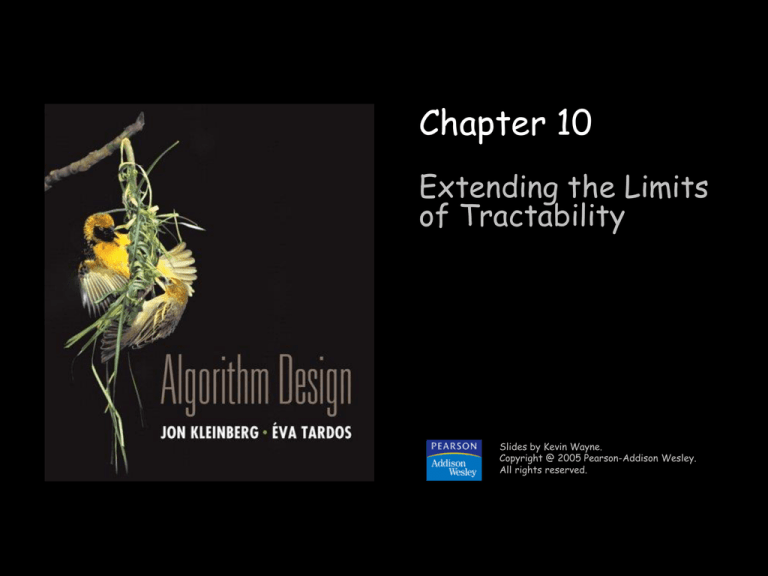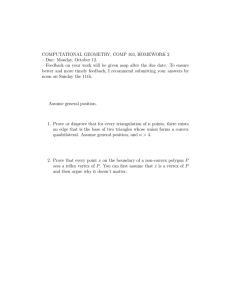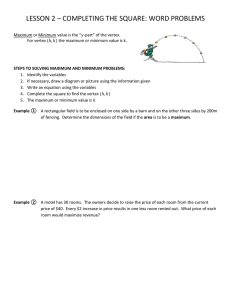
Chapter 10
Extending the Limits
of Tractability
Slides by Kevin Wayne.
Copyright @ 2005 Pearson-Addison Wesley.
All rights reserved.
1
Coping With NP-Completeness
Q. Suppose I need to solve an NP-complete problem. What should I do?
A. Theory says you're unlikely to find poly-time algorithm.
Must sacrifice one of three desired features.
Solve problem to optimality.
Solve problem in polynomial time.
Solve arbitrary instances of the problem.
This lecture. Solve some special cases of NP-complete problems that
arise in practice.
2
10.1 Finding Small Vertex Covers
Vertex Cover
VERTEX COVER: Given a graph G = (V, E) and an integer k, is there a
subset of vertices S V such that |S| k, and for each edge (u, v)
either u S, or v S, or both.
1
6
2
7
3
8
4
9
5
10
k=4
S = { 3, 6, 7, 10 }
4
Finding Small Vertex Covers
Q. What if k is small?
Brute force. O(k nk+1).
Try all C(n, k) = O(nk) subsets of size k.
Takes O(k n) time to check whether a subset is a vertex cover.
Goal. Limit exponential dependency on k, e.g., to O(2k k n).
Ex. n = 1,000, k = 10.
Brute. k nk+1 = 1034 infeasible.
Better. 2k k n = 107 feasible.
Remark. If k is a constant, algorithm is poly-time; if k is a small
constant, then it's also practical.
5
Finding Small Vertex Covers
Claim. Let u-v be an edge of G. G has a vertex cover of size k iff
at least one of G { u } and G { v } has a vertex cover of size k-1.
delete v and all incident edges
Pf.
Suppose G has a vertex cover S of size k.
S contains either u or v (or both). Assume it contains u.
S { u } is a vertex cover of G { u }.
Pf.
Suppose S is a vertex cover of G { u } of size k-1.
Then S { u } is a vertex cover of G. ▪
Claim. If G has a vertex cover of size k, it has k(n-1) edges.
Pf. Each vertex covers at most n-1 edges. ▪
6
Finding Small Vertex Covers: Algorithm
Claim. The following algorithm determines if G has a vertex cover of
size k in O(2k kn) time.
boolean Vertex-Cover(G, k) {
if (G contains no edges)
return true
if (G contains kn edges) return false
let (u, v) be any edge of G
a = Vertex-Cover(G - {u}, k-1)
b = Vertex-Cover(G - {v}, k-1)
return a or b
}
Pf.
Correctness follows previous two claims.
There are 2k+1 nodes in the recursion tree; each invocation takes
O(kn) time. ▪
7
Finding Small Vertex Covers: Recursion Tree
if k 1
cn
T (n, k )
T (n, k ) 2k c k n
2T (n, k 1) ckn if k 1
k
k-1
k-1
k-2
k-2
k-2
k-2
k-i
0
0
0
0
0
0
0
0
8
10.2 Solving NP-Hard Problems on Trees
Independent Set on Trees
Independent set on trees. Given a tree, find a maximum cardinality
subset of nodes such that no two share an edge.
Fact. A tree on at least two nodes has
at least two leaf nodes.
degree = 1
Key observation. If v is a leaf, there exists
a maximum size independent set containing v.
u
v
Pf. (exchange argument)
Consider a max cardinality independent set S.
If v S, we're done.
If u S and v S, then S { v } is independent S not maximum.
IF u S and v S, then S { v } { u } is independent. ▪
10
Independent Set on Trees: Greedy Algorithm
Theorem. The following greedy algorithm finds a maximum cardinality
independent set in forests (and hence trees).
Independent-Set-In-A-Forest(F) {
S
while (F has at least one edge) {
Let e = (u, v) be an edge such that v is a leaf
Add v to S
Delete from F nodes u and v, and all edges
incident to them.
}
return S
}
Pf. Correctness follows from the previous key observation. ▪
Remark. Can implement in O(n) time by considering nodes in postorder.
11
Weighted Independent Set on Trees
Weighted independent set on trees. Given a tree and node weights wv > 0,
find an independent set S that maximizes vS wv.
Observation. If (u, v) is an edge such that v is a leaf node, then either
OPT includes u, or it includes all leaf nodes incident to u.
Dynamic programming solution. Root tree at some node, say r.
OPTin (u) = max weight independent set
rooted at u, containing u.
OPTout(u) = max weight independent set
rooted at u, not containing u.
r
u
OPTin (u)
wu
OPTout (u)
OPTout (v)
v children (u)
v
w
x
max OPTin (v), OPTout (v)
v children (u)
children(u) = { v, w, x }
12
Independent Set on Trees: Greedy Algorithm
Theorem. The dynamic programming algorithm find a maximum
weighted independent set in trees in O(n) time.
Weighted-Independent-Set-In-A-Tree(T) {
Root the tree at a node r
foreach (node u of T in postorder) {
if (u is a leaf) {
Min [u] = wu
ensures a node is visited after
all its children
Mout[u] = 0
}
else {
Min [u] = vchildren(u) Mout[v] + wv
Mout[u] = vchildren(u) max(Mout[v], Min[v])
}
}
return max(Min[r], Mout[r])
}
Pf. Takes O(n) time since we visit nodes in postorder and examine each
edge exactly once. ▪
13
Context
Independent set on trees. This structured special case is tractable
because we can find a node that breaks the communication among the
subproblems in different subtrees.
u
u
see Chapter 10.4, but proceed with caution
Graphs of bounded tree width. Elegant generalization of trees that:
Captures a rich class of graphs that arise in practice.
Enables decomposition into independent pieces.
14
10.3 Circular Arc Coloring
Wavelength-Division Multiplexing
Wavelength-division multiplexing (WDM). Allows m communication
streams (arcs) to share a portion of a fiber optic cable, provided they
are transmitted using different wavelengths.
Ring topology. Special case is when network is a cycle on n nodes.
Bad news. NP-complete, even on rings.
Brute force. Can determine if
k colors suffice in O(km) time by
trying all k-colorings.
c
b a
1
4
2
e
Goal. O(f(k)) poly(m, n) on rings.
f
d
3
n = 4, m = 6
16
Wavelength-Division Multiplexing
Wavelength-division multiplexing (WDM). Allows m communication
streams (arcs) to share a portion of a fiber optic cable, provided they
are transmitted using different wavelengths.
Ring topology. Special case is when network is a cycle on n nodes.
Bad news. NP-complete, even on rings.
Brute force. Can determine if
k colors suffice in O(km) time by
trying all k-colorings.
c
b a
1
4
2
e
Goal. O(f(k)) poly(m, n) on rings.
f
d
3
n = 4, m = 6
17
Review: Interval Coloring
Interval coloring. Greedy algorithm finds coloring such that number of
colors equals depth of schedule.
maximum number of streams at one location
c
d
b
a
f
j
g
i
h
e
Circular arc coloring.
Weak duality: number of colors depth.
Strong duality does not hold.
max depth = 2
min colors = 3
18
(Almost) Transforming Circular Arc Coloring to Interval Coloring
Circular arc coloring. Given a set of n arcs with depth d k,
can the arcs be colored with k colors?
Equivalent problem. Cut the network between nodes v1 and vn. The arcs
can be colored with k colors iff the intervals can be colored with k
colors in such a way that "sliced" arcs have the same color.
v1
colors of a', b', and c' must correspond
to colors of a", b", and c"
v0
v4
v2
v3
v0
v1
v2
v3
v4
v0
19
Circular Arc Coloring: Dynamic Programming Algorithm
Dynamic programming algorithm.
Assign distinct color to each interval which begins at cut node v0.
At each node vi, some intervals may finish, and others may begin.
Enumerate all k-colorings of the intervals through vi that are
consistent with the colorings of the intervals through vi-1.
The arcs are k-colorable iff some coloring of intervals ending at cut
node v0 is consistent with original coloring of the same intervals.
yes
c'
3
e
3
1
e
3
1
e
3
1
a"
3
2
1
2
b'
2
b'
2
2
f
2
2
f
2
2
b"
2
3
2
1
a'
1
d
1
3
d
1
3
c"
1
3
c"
1
1
3
3
v0
v1
v2
v3
v4
v0
20
Circular Arc Coloring: Running Time
Running time. O(k! n).
n phases of the algorithm.
Bottleneck in each phase is enumerating all consistent colorings.
There are at most k intervals through vi, so there are at most k!
colorings to consider.
Remark. This algorithm is practical for small values of k (say k = 10)
even if the number of nodes n (or paths) is large.
21
Extra Slides
Vertex Cover in Bipartite Graphs
Vertex Cover
Vertex cover. Given an undirected graph G = (V, E), a vertex cover is a
subset of vertices S V such that for each edge (u, v) E, either
u S or v S or both.
1
1'
2
2'
3
3'
4
4'
5
5'
S = { 3, 4, 5, 1', 2' }
|S| = 5
24
Vertex Cover
Weak duality. Let M be a matching, and let S be a vertex cover.
Then, |M| |S|.
Pf. Each vertex can cover at most one edge in any matching.
1
1'
2
2'
3
3'
4
4'
5
5'
M = 1-2', 3-1', 4-5'
|M| = 3
25
Vertex Cover: König-Egerváry Theorem
König-Egerváry Theorem. In a bipartite graph, the max cardinality of a
matching is equal to the min cardinality of a vertex cover.
1
1'
2
2'
3
3'
4
4'
5
5'
S* = { 3, 1', 2', 5'}
|S*| = 4
M* = 1-1', 2-2', 3-3', 5-5'
|M*| = 4
26
Vertex Cover: Proof of König-Egerváry Theorem
König-Egerváry Theorem. In a bipartite graph, the max cardinality of a
matching is equal to the min cardinality of a vertex cover.
Suffices to find matching M and cover S such that |M| = |S|.
Formulate max flow problem as for bipartite matching.
Let M be max cardinality matching and let (A, B) be min cut.
1
1
s
1'
2
2'
3
3'
4
4'
5
5'
1
t
27
Vertex Cover: Proof of König-Egerváry Theorem
König-Egerváry Theorem. In a bipartite graph, the max cardinality of a
matching is equal to the min cardinality of a vertex cover.
Suffices to find matching M and cover S such that |M| = |S|.
Formulate max flow problem as for bipartite matching.
Let M be max cardinality matching and let (A, B) be min cut.
Define LA = L A, LB = L B, RA = R A, RB = R B.
Claim 1. S = LB RA is a vertex cover.
– consider (u, v) E
– u LA, v RB impossible since infinite capacity
– thus, either u LB or v RA or both
Claim 2. |S| = |M|.
– max-flow min-cut theorem |M| = cap(A, B)
– only edges of form (s, u) or (v, t) contribute to cap(A, B)
– |M| = cap(A, B) = |LB| + |RA| = |S|. ▪
28
Register Allocation
Register Allocation
Register. One of k of high-speed memory locations in computer's CPU.
say 32
Register allocator. Part of an optimizing compiler that controls which
variables are saved in the registers as compiled program executes.
Interference graph. Nodes are "live ranges" (variables or
temporaries). There is an edge between u and v if there exists an
operation where both u and v are "live" at the same time.
Observation. [Chaitin, 1982] Can solve register allocation problem iff
interference graph is k-colorable.
Spilling. If graph is not k-colorable (or we can't find a k-coloring), we
"spill" certain variables to main memory and swap back as needed.
typically infrequently used
variables that are not in inner loops
30
A Useful Property
Remark. Register allocation problem is NP-hard.
Key fact. If a node v in graph G has fewer than k neighbors,
G is k-colorable iff G { v } is k-colorable.
delete v and all incident edges
Pf. Delete node v from G and color G { v }.
If G { v } is not k-colorable, then neither is G.
If G { v } is k-colorable, then there is at least one remaining color
left for v. ▪
v
k=3
k=2
G is 2-colorable even though
all nodes have degree 2
31
Chaitin's Algorithm
Vertex-Color(G, k) {
say, node with fewest neighbors
while (G is not empty) {
Pick a node v with fewer than k neighbors
Push v on stack
Delete v and all its incident edges
}
while (stack is not empty) {
Pop next node v from the stack
Assign v a color different from its neighboring
nodes which have already been colored
}
}
32
Chaitin's Algorithm
Theorem. [Kempe 1879, Chaitin 1982] Chaitin's algorithm produces a
k-coloring of any graph with max degree k-1.
Pf. Follows from key fact since each node has fewer than k neighbors.
algorithm succeeds in k-coloring
many graphs with max degree k
Remark. If algorithm never encounters a graph where all nodes have
degree k, then it produces a k-coloring.
Practice. Chaitin's algorithm (and variants) are extremely effective
and widely used in real compilers for register allocation.
33






